Making homemade soap is one of my new favorite skills. I especially love soaps that are made with foraged and wildcrafted ingredients. This wild rose and yarrow soap is lovely and great for the skin!
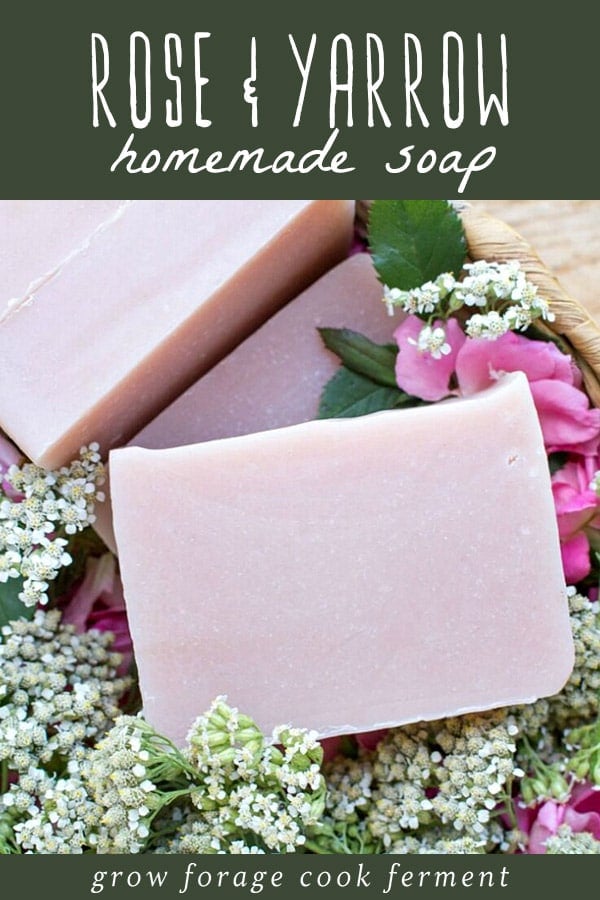
Want to save this post for later?
Wild Rose and Yarrow Soap Recipe
My friend Jan Berry, blogger at The Nerdy Farm Wife and author of The Big Book of Homemade Products for Your Skin, Health & Home and the Natural Soapmaking eBook, has a great recipe for wild rose and yarrow soap that she is sharing with us!
She has a great soapmaking book as well called Simple & Natural Soapmaking that is full of awesome soap recipes similar to this one.
This natural soap recipe was inspired by a tangle of roses growing right by a patch of wild yarrow I discovered one day on my morning walk. They looked so beautiful growing together, I thought they’d make a perfect pairing in soap too!
If you are new to making soap, please take a look at my how to make soap for beginners post before proceeding. It will walk you through the process step by step!
Wild Rose and Yarrow Oil Infusion
Before you make this recipe, you’ll first need to make a rose and yarrow oil infusion.
To make the infusion, fill a canning jar about half-way with dried rose petals and yarrow. Pour olive oil over the dried flowers until completely covered by several extra inches of oil. Cover with a lid and infuse for several weeks, then strain.
For a quicker infusion, set the uncovered jar into a saucepan filled with a few inches of water. Heat the pan over low heat for 2 to 3 hours. Cool and strain.
Use the rose and yarrow infused olive oil in the soap recipe below.
You can also make your own wooden soap mold for homemade soap making! Jan’s Natural Soap Making eBook and eCourse explains how to do this!
This wild rose and yarrow soap looks so amazing, and beautiful, too! I can’t wait to try out this recipe, plus all of the other foraged and garden fresh natural soap recipes that are in Simple & Natural Soapmaking.
Natural Soap Making eBook & eCourse
If you are interested in learning more about making soap, Jan has a Natural Soap Making eBook and Soap Making Success eCourse that I highly recommend. First it covers the basics of soap making, then over the course of six lessons you’ll learn how to make natural soap successfully with these ingredients and methods:
- Fruits & Veggies
- Flowers & Herbs
- Alternative Liquids
- Natural Colorants
- Simple Soap Designs
- Soap Label Designs
Check out Natural Soap Making and Soapmaking Success to learn how to become more confident and adventurous in your soap making!
I hope you get a chance to make this wild rose and yarrow soap!
More Natural Soap Recipes
Once you start making homemade soap, you’ll never be able to go back to store bought bar soap again. Have some fun and try these other soap recipes too!
Wild Rose and Yarrow Soap
Equipment
Ingredients
Rose and Yarrow Infused Olive Oil
- ½ cup dried rose petals approximately
- ½ cup dried yarrow flowers approximately
- 20 ounces olive oil approximately
Solid Oils
- 6.5 oz coconut oil
- 2 oz kokum or cocoa butter
Liquid Oils
- 15 oz olive oil (infused with wild rose and yarrow, see instructions above)
- 3 oz sweet almond oil (can also use sunflower oil)
- 1.5 oz castor oil (add at trace)
- 25 g geranium essential oil for scent
Instructions
Rose and Yarrow Infused Herbal Oil
- To infuse the olive oil with the flowers, add the dried rose petals and yarrow to a quart canning jar.
- Pour about 20 ounces of olive oil over the dried flowers, making sure they are completely covered by several extra inches of oil. (This is slightly more than the amount of olive oil called for in the soap recipe because some of the oil will saturate the flowers, and coat the sides of the jar, etc. so the final yield will be less.)
- Cover with a lid and infuse for several weeks, then strain. Use in place of regular olive oil in soap recipes.
Step 1: Make the Lye Solution
- Wearing protective gloves and eyewear, carefully stir the lye (sodium hydroxide) into the distilled water until dissolved. Next, stir in the rose clay. Work in an area with good ventilation and be careful not to breathe in the fumes. Set the lye solution aside to cool for about 30 or 40 minutes or until the temperature drops to around 100 to 110°F (38 to 43°C).
Step 2: Prepare the Oils
- Gently heat the coconut oil and kokum/cocoa butter on low heat until melted. When the solid oils are melted, take the pan off the heat and pour in the liquid oils. This helps cool down the melted oils, while warming up the room temperature oils.
Step 3: Mixing
- Pour the cooled lye solution into the warmed oils. Using a combination of hand stirring and an immersion blender, also called a stick blender, stir the soap batter until it thickens and reaches a light trace. Trace is when the soap has thickened enough so when you drizzle a small amount of the batter across the surface, it will leave a fleeting, but visible imprint or “trace” before sinking back in.
Step 4: Add the Essential Oil
- When the soap batter has thickened to trace, or the consistency of warm custard, stir in the essential oil(s) for scent.
Step 5: Pour in Mold
- Pour the soap batter into your soap mold. Cover lightly with wax or freezer paper, then a towel or light blanket. Peek at the soap every so often; if it starts developing a crack, uncover and move to a cooler location.
Step 6: Cut & Cure
- Keep the soap in the mold for 1 to 2 days, or until it’s easy to remove, then slice it into bars when it’s firm enough not to stick to your cutting tool. Cure on coated cooling racks or sheets of wax paper for about 4 weeks before using. The soap is safe to touch 48 hours after making it but it needs the extra time to allow the excess moisture to evaporate out.

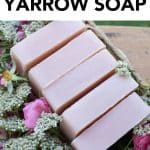
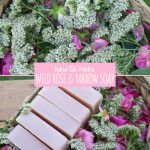
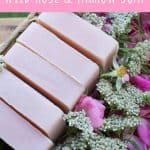
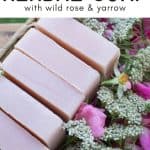
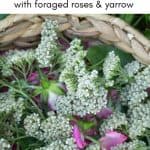
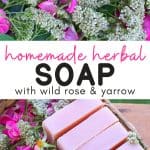
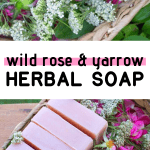
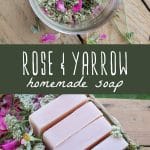
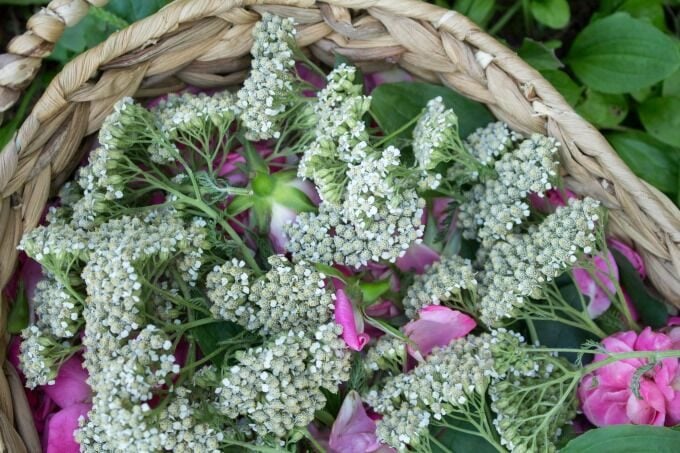
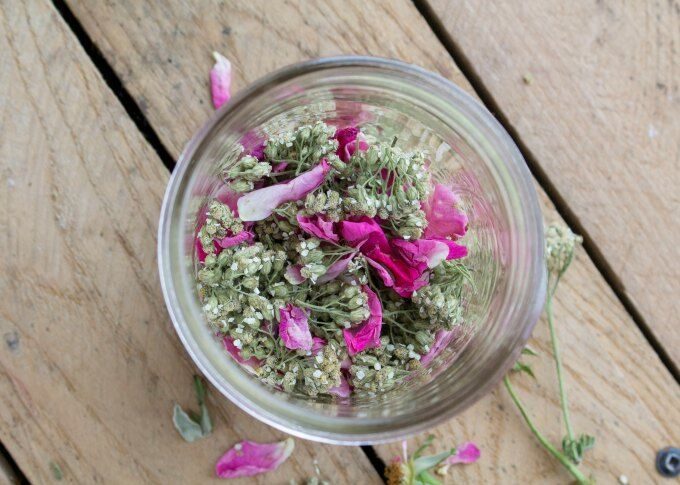
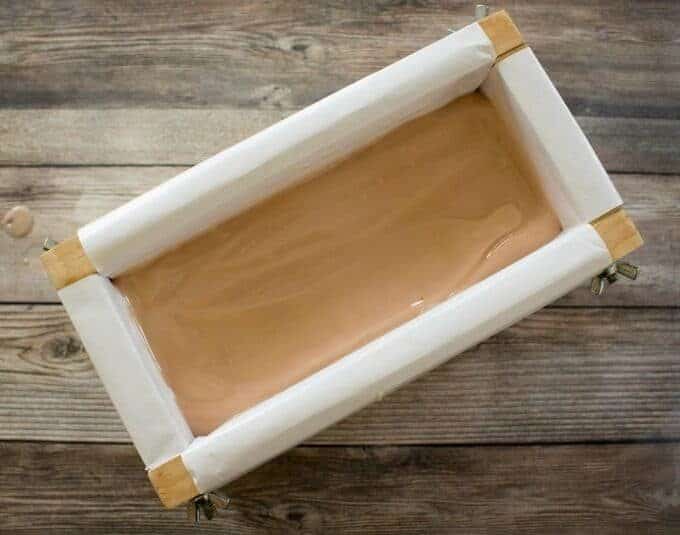
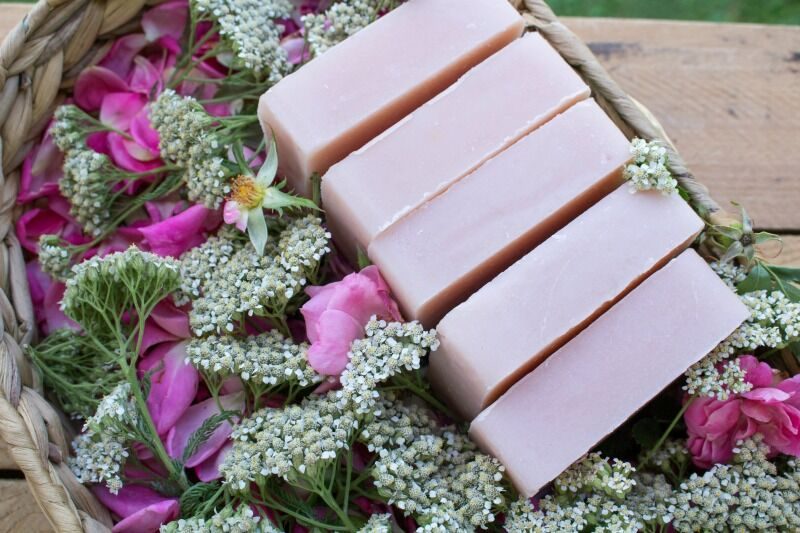
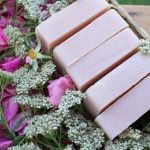

Can I do equal substitutions of shea butter for cocoa butter without changing the lye amount?
They can be swapped in equal amounts, but you will need to recalculate the lye amount. Each butter has a different saponification value.
Does the soap smell like yarrow? Or would a yarrow essential oil be needed?
Hi, I’d like to downsize the recipe and I’ve worked out the percentages of oils and butters but need the water to lye ratio and the super fat percentage, would you be able to provide this number please?
Hi! Colleen
Thank you for sharing this recipe!
You’re welcome. I hope you enjoy it!
Is there anything you can substitute for castor oil? I have read that it is not good for rosacea. Thanks!
Definitely! You can substitute it for any other oil you like. Jojoba is always a good option.
I made the soap a few months ago. I love the soap and those that I’ve shared it with love it also. The rose clay gives it a beautiful rose color. Thanks for sharing the recipe.
Is there anything substitutes lye because lye isn’t so good for the body?
When the curing is done 4-6 weeks all of the lye has evaporated. That’s one of the reasons why you can’t use the the soap right after you make it. Lye will burn your skin.
Can’t make soap without lye. Use food graded lye
Did you know they use food graded lye to make pretzels.
Lye doesn’t evaporate from soap, but joins with the fat molecules. A good soap formula will have the proper lye to fat ratio for all the lye molecules to bond with the fat molecules. A lab would not then be able to find any lye in that soap as all lye have bonded with fats. That’s called saponification. A formula with more fats than will bond with lye is called super fatted soap. This soap is extra moisturizing, though is may have a shorter shelf life.
The wild roses are blooming right now and I really want to start infusing some oil to try this. Why is it important to have dried rose petals and yarrow? If I have fresh in my fields right now – can I just use fresh flowers to infuse?
It’s generally a better idea to use dried plant material when making infused oil, otherwise the oil can go rancid.
And risking getting mold too
Is there anything to substitute the rose clay with? That is the only ingredient I dont have. Can you use mica powder instead?
I’m soo excited to try this recipe. I’ve had dried yarrow for awhile wanting to use it.
Thank you for sharing this recipe!
Could you use Yarrow powder instead ?
Thank You
I didn’t see any yarrow or wild rose added (unless you are thinking of geranium rose EO as the rose part of it) added. Did that get left out of the recipe?
The olive oil is infused with wild rose and yarrow, if you read above the recipe where it says “Before you make this recipe” it explains how to do this.
What gives it the pink color? I don’t see any colorants, micas, etc. Is it from the infused oil?
The recipe calls for rose clay :)
I don’t understand the wild rose and yarrow soap recipe that has no wild rose and yarrow ingredients?
Hi Roz, the olive oil is infused with wild rose and yarrow, if you read above the recipe where it says “Before you make this recipe” it explains how to do this.
I love all the substitution options, and how much of this recipe uses ingredients that I really could forage from my own home!
What size soap mold do you use? Is there an easy way to figure how a recipe will fit into your molds?
This soap sounds so lovely! I think I will get Jan’s book; it looks to be very informative. I like her statement about not letting fear, of lye, stop one from making something very rewarding. I have taken a soap making workshop and must admit am hesitant to try it alone at home. Silly I know but her safety instructions and this recipe make me feel as though I can do it!!!